Abstract
The Tarim Basin, a significant region of coal-derived gas generation in China, has widely dispersed coal measure source rocks, especially in the Kuqa Depression. The typical coal measure strata from the Kuqa River and Kapushaliang River sections in the Kuqa Depression were systematically sampled. According to a conventional geochemical analysis (including materials and lithology), a total of 25 typical coal measure source rock samples were chosen for chromatography and chromatography–mass spectrometry examination. It was demonstrated that there were significant discrepancies in the coal source rock samples, particularly the coal rock from the Kuqa River section and the Kapushaliang River section. The specific performance of the Kuqa River section was characterized by a high Pr/Ph ratio (up to 9.29), a low gammacerane ratio, a low abundance of tricyclic terpane, and an “L”-type distribution of regular steranes, all of which are consistent with the properties of humic coal found in freshwater lakes that have undergone partial oxidation. The Kapushaliang River section, by contrast, exhibited a low Pr/Ph ratio (<1.0), a high gammacerane ratio, a concentration of tricyclic terpane comparable to that of hopane, and a distribution of regular steranes in a “V” shape, all of which indicate a strongly reduced saline water environment. Additionally, the degree of thermal evolution is not the key factor resulting in the above biomarker diversity within the CSRs, which was supported by the poor correlation between the maturity parameters (Ro%, Tmax °C), the sedimentary environment-related parameters (such as Pr/Ph and Ga/C31H), and the biogenic-related parameters (such as ∑tricyclic terpane/∑ hopane and ∑sterane/∑hopane). A comparative analysis suggested that transgression-related changes in the redox conditions and parent materials triggered the biomarker diversity within the CSRs, resulting in a large difference in the hydrocarbon-forming parent materials between the two abovementioned outcrop sections. These might provide some insight for hydrocarbon exploration from CSRs, which have been attracting increasing attention in China, with proven coal reserves are ranked first in the world.
1. Introduction
Coal measure source rock is an important part of gas yield and petroliferous source rock; it can be formed in various types of basins, and it is widely developed around the world. The mechanism and distribution laws governing coal measure source rock formation have been the subject of extensive inquiry [1,2,3,4,5,6,7,8]. Coal measure source rock has been used as a potential source rock for many years; M Lutz found that coal measure source rock from the Carboniferous could be a source for the large-scale generation of methane, and the same gas pool has been found in northwest Europe’s southern Permian coal measure source rock [9,10]. Duncan argued that coal measure source rock plays an indispensable role in gas generation. According to the research, coal measure source rock could even have a special type of “self-generation and self-storage” capacity according to a geochemical characteristic comparison [11,12,13,14]. With the help of further research, coal-formed gas has increasingly been found in various basins [7,15,16] and by researchers who are simultaneously working on the factors that limit the petroleum potential of coal measure source rock [5,17,18,19,20]. However, coal seams are not only warm beds of gas but also a source of oil. Compared with gas generation, Thomas found a mass of oil derived from land plants in Australia. In addition to marine facies, coastal facies and delta facies generally have a higher potential for oil generation. Meanwhile, Durand commenced using a new geochemical approach to assess the oil generation of coal [21,22]. Levine [6] summarized the evolution of coal as source rock and reservoir rock for oil and gas in 1993. A couple years ago, Wilkins R. paid attention to the phenomenon that some coal possesses a strong oil-generating capacity and put forward the prospect of coal as a primary oil-generating source rock; the coal measure source rock in the Jurassic Turpan basin has been found to be a major source of petroleum [23,24]. With the growing research on coal measure source rock, it has been discovered that coal measure source rock plays an important role in various types of source rock, and commercial coal measure source rock has increasingly been explored. Hence, research on coal has never been suspended in order to better understand the rules of how petroleum is generated from coal measure source rock and find profitable coal measure source rock. A series of studies on pyrolysis, biomarkers distribution patterns, macerals characteristics, isotopic distribution, sequence stratigraphy, and sedimentary facies analysis have been carried out [19,25,26,27,28,29,30,31,32,33,34,35]. From discovery to mining to search, coal measure source rock research has been through long-term development, and to this day, coal measure source rock is still being pursued as a good source rock and holds much sway.
Tarim Basin is one of China’s famous petroliferous basins [33,34,35]. Coal measure source rocks are widely developed in the Kuqa Depression of the Tarim Basin. Hence, as they play an important role in petroleum generation, numerous studies have been carried out on coal measure source rock in the Kuqa Depression. Throughout the research, the coal measure rock in the Kuqa Depression was considered to be the main source of gas generation. In order to decipher the rules of how gas and oil are generated from the coal measure source rock and explore a much more commercial fuel pool in the Kuqa Depression and even the whole Tarim Basin, much effort has been put into the study of the coal measure source rock in the Kuqa Depression. Up to now, the study of coal measure source rock in the Kuqa Depression has consisted of the evaluation of source rock and geochemical characteristics analysis [36,37,38,39]. The feature description involves hydrocarbon-generating kinetics, oil source correlation, and resource potential assessment [12,40,41]. As an effective and commonly used tool, geochemistry analysis can always provide accurate and effective information. With the help of a molecular marker, we can differentiate the sedimentary environment, reconstruct the ancient climate and events, and recognize the source input, which can help us locate commercial source rock. Therefore, we performed a series of geochemical analyses on the coal measure source rock of the Kuqa Depression in Tarim Basin, and unlike the former study, we paid close attention to the abnormal distribution pattern of the complete series’ biomarker compounds in the coal measure source rock. The distribution patterns and differential changes in the biomarker compounds were studied by comparison to figure out the characteristics of the coal measure source rocks in the Kuqa Depression and the rules that govern how commercial coal measure source rocks are shaped.
2. Geological Setting
The Kuqa Depression is a secondary tectonic unit located in the northernmost part of the Tarim Basin. The north side is bounded by the Tianshan Piedmont fault zone, the south side is adjacent to the Tabei uplift, and the east and west sides are bordered by the Kurchu and Wushi sags [42] (Figure 1). Under the influence of the Tianshan Mountains and the Tabei uplift, the Kuqa Depression is elongated and gradually narrowed from southwest to northeast, with a total area of 2.6 × 104 km2. The seasonal rivers formed by melting of snow and water from the northern Tianshan Mountains carry sediments into the Kuqa Depression, and four stratigraphic sections of the Awat River, Kapushaliang River, Kelasu River, and Kuqa River are developed in the depression.
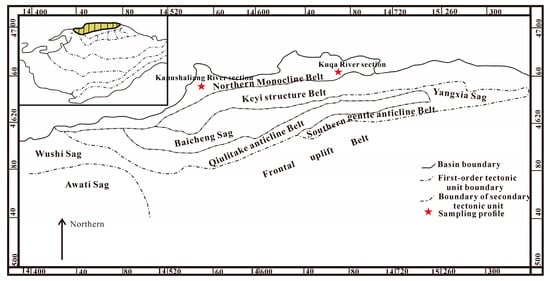
Figure 1.
Structural map of the Kuqa Depression, Tarim Basin.
The total thickness of the Triassic–Jurassic source rocks in the Kuqa Depression varies greatly. The Kuqa River profile is the largest, and the next largest is the Kapushaliang River profile, which is approximately 1000 m. In the Yinan 2 well and the Awat River profile, the thickness is lower, at 600~900 m; the Takla profile and the Xiaotailan River profile are also distributed at around 450 to 500 m; the thicknesses of the hydrocarbon source rocks in the Kurgan profile, Tugerming profile, and Yang 1 well are poor.
3. Samples and Experiment
3.1. Samples
In this research, 25 coal measure source rocks were collected from the Kuqa River section and the Kapushaliang River section. Among them, 15 samples were collected from the Kuqa River section (KC), including 11 coal rock samples, 2 carbonaceous mudstone samples, and 2 mudstone samples. There were 10 samples from the Kapushaliang River profile (KP), including 5 coal rock samples, 3 carbonaceous mudstone samples, and 2 mudstone samples. Whole rock maceral analysis, vitrinite reflectance measurement, rock pyrolysis, organic carbon measurement, extraction, group component separation, and GC–MS quantitative analysis were performed on 25 typical coal measure source rock samples. The basic geochemical data of the samples are given in Table 1.

Table 1.
Basic geochemistry information of the Mesozoic coal measure source rock in the Kuqa Depression.
The TOC range of the Kuqa River section involved in the study was between 1.88% and 67.19%, and the hydrocarbon generation potential range was 2.14 mg/g~227.97 mg/g. It can be seen in Table 1 that the values of the hydrocarbon generation potential of the different lithology source rocks in the coal measure source rocks were obviously different, which was manifested in the highest hydrocarbon generation potential of the coal, with some samples being greater than 100 mg/g. The hydrocarbon generation potential of the carbonaceous mudstone was the second highest, and the hydrocarbon generation potential of the mudstone was the lowest, suggesting that the coal rock in the study area had a good hydrocarbon generation ability. The macerals were rich in vitrinite (the content of the vitrinite was between 50.0% and 99.4%), with small amounts of inertinite, sapropel, and exinite. The TI index ranged from −64.4 to −1.3, mainly type III kerogen, which corresponds to the properties of humic coal. The range of the Ro was 0.511~0.696%, and the range of Tmax was 430~454 °C, indicating that the thermal evolution of the organic matter of the source rocks in this section is low maturity–maturity.
The TOC range of the Kapushaliang River section was 0.69~83.16%, and the hydrocarbon generation potential range was 0.4 mg/g~40.20 mg/g. The results showed that the hydrocarbon generation potential of the different lithological source rocks was similar to that in the Kuqa River section, and the overall performance was coal rock > carbonaceous mudstone > mudstone; vitrinite had an absolute advantage in macerals (vitrinite content is 81.9~100%), the inertinite content was weak (inertinite content: 0.0~18.1%), and there were almost no sapropel groups or exinite groups. The TI index ranged from −68.5 to −0.2, mainly type III kerogen. The range of the Ro was 0.984~1.485%, and the range of the Tmax was 466~529 °C, indicating that the thermal evolution of the source rocks in this section is in the mature–high mature stage.
3.2. Experiment
From a molecular point of view, the source of organic matter, the difference in the sedimentary environment, the degree of the thermal evolution of the coal, and the carbonaceous mudstone and mudstone in the study area were revealed, which provided the geochemical basis for the search for natural gas.
The surface soil was excavated during the sampling of the surface outcrop, and the sampling was carried out when the fresh surface was encountered (approximately 1 m) to ensure the freshness of the sample. Soxhlet extraction was carried out for hydrocarbon source rocks. Chloroform bitumen “A” was obtained by continuous extraction with chloroform for 72 h in a water bath at 70 °C, and chloroform bitumen “A” was obtained by rotary evaporation. Then, the extracted bitumens were fractionated into saturated hydrocarbons, aromatic hydrocarbons, nonhydrocarbons, and asphaltenes via open-column chromatography. Only the saturated hydrocarbons were analyzed in this study. Saturated hydrocarbons were analyzed using gas chromatography–mass spectrometry (GC–MS) in the full scan mode (scanning range: 50–500 amu). A GC–MS analysis was carried out using an HP6890N/HP5973MSD analyzer coupled with an HP-5MS fused silica capillary column (30 m × 0.25 mm × 0.25 μm), and helium was used as the carrier gas. The GC temperature was programmed to start at 50 °C for one minute, raised to 100 °C at 20 °C/min, and then increased to 315 °C at 3 °C/min. For the analysis of the biomarkers, the fragmentograms for triterpanes (m/z191) and steranes (m/z217) were recorded.
4. Discussion and Results
4.1. Distribution Characteristics of Chain Alkanes
4.1.1. Isoprenoid Alkanes
Isoprenoid alkanes include two types: regular and irregular. The regular type is mainly composed of a phytane series of compounds (≤C20) and high-carbon-number (>C20) regular isoprenoid alkanes, which are basically sources from the pigment of photosynthetic organisms, while the irregular type is mainly of a bacterial source. The distribution of the Pr/Ph values from the different sections of the Kuqa Depression is shown in Figure 2.
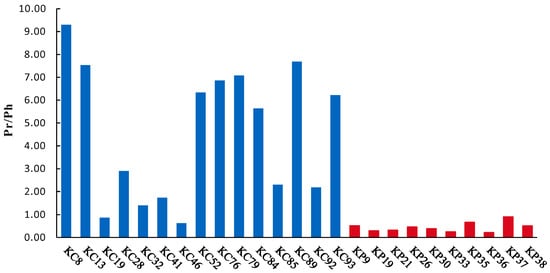
Figure 2.
The distribution characteristics of the Pr/Ph values of the coal measure source rocks from the different sections of the Mesozoic in the Kuqa Depression.
Studies have indicated that the Pr/Ph ratio is a good indicator of a source rock’s depositional environment, especially the redox properties. The Pr/Ph ratios of the Kuqa River section and the Kapushaliang River section in the Kuqa Depression were different, as shown in Table 2. Generally speaking, the Pr/Ph ratio of the humic coal in the Kuqa River section was higher than that of the Kapushaliang River section. The distribution range of the Pr/Ph ratio of the coal rock samples from the Kuqa River section was between 1.74 and 9.29, which is greater than 1, and the average value was 5.33. On the contrary, the Pr/Ph ratio of the coal rock samples from the Kapushaliang River section ranged from 0.25 to 0.91, all less than 1, with an average of 0.46. This phenomenon is rarely reported in the relevant literature, and the composition and distribution of other biomarkers in this type of coal also have obvious particularity.

Table 2.
Parameter diagram of the main biomarker compounds of the Mesozoic coal measure source rocks in the Kuqa Depression, Tarim Basin.
In addition to the Pr/Ph values, the Pr/nC17 and Ph/nC18 relationship diagrams also show that the oxidation–reduction properties of the source rock samples from the Kuqa River section and the Kapushaliang River section were completely different (Figure 3). Specifically, the samples of coal-bearing source rocks in the Kuqa River section were generally in an oxidizing sedimentary environment, while the samples of coal-bearing source rocks in the Kapushaliang section were in a reduced sedimentary environment. The macerals of the coal in the study area are all type III kerogen, which is a typical humic coal, indicating that the redox properties of the sedimentary environment of the two sections are obviously different.
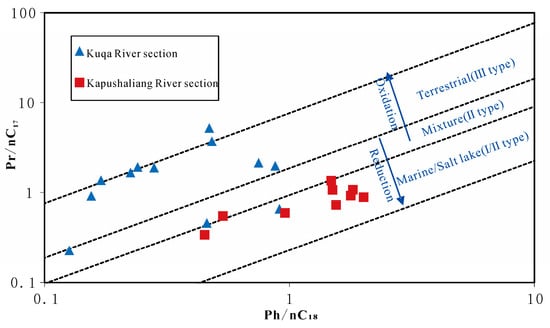
Figure 3.
Relationship between Pr/nC17 and Ph/nC18 of the Mesozoic coal measure source rocks in the Kuqa Depression, Tarim Basin.
Through comparison, it was found that the regular isoprenoids of the Kuqa River section and the Kapushaliang River section in the Kuqa Depression had significant differences. In the Kapushaliang River section, we detected abundant regular high-carbon isoprenoid alkanes, mainly C21-C26 (IP21~IP26) compounds. The order of the chromatographic peaks of the related compounds is shown in Figure 4. There have been few studies on the number of regular high-carbon isoprenoid alkanes in the Kuqa Depression, Tarim Basin, but according to the reports in the literature, these compounds are all bacterial compounds [43,44]. The high-carbon regular isoprenoid alkanes in the study area were mainly distributed in the Kapushaliang River section with a low Pr/Ph ratio, indicating that these compounds formed in a strong reducing environment and likely contributed bacterial sources suitable for relatively high salinity environments.
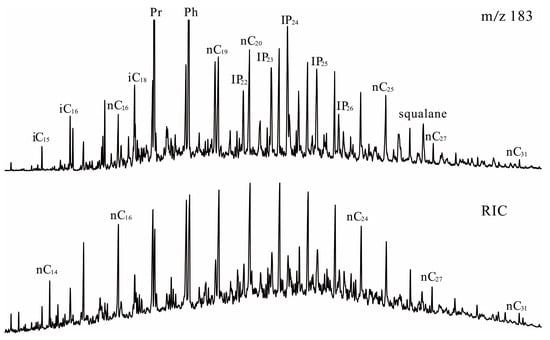
Figure 4.
Composition and distribution of isoprenoid alkanes in the Mesozoic humic coal in the Kuqa Depression (from KP38 coal sample).
Other irregular isoprenoid alkanes, such as squalane, were also detected in these samples of high-carbon-number regular isoprenoid alkanes (Figure 4). According to research, squalane generally appears in high-salt environments in high abundance [44]. The detection of squalane and its distribution relationship with other isoprenoid alkanes indicates that there is a special coal-forming environment in the Jurassic of the Kuqa Depression.
4.1.2. Monomethyl Branched Alkanes (MMAs)
Isomeric (2-methyl-) and anti-isomerized (3-methyl-) alkanes are common compounds in different types of source rocks and crude oils that mainly indicate the contribution of bacterial wax sources [45]. The origin of MMAs with a medium chain length may be more special than that of isomeric alkanes (2-methyl-) and anti-isomeric alkanes (3-methyl-) [46]. Teng L. [47] systematically studied the relationship between the distribution of 2- and 3-methylalkanes and the source of organic matter and the depositional environment of the carbon number distribution of C13~C34 in the Kuqa Depression, Tarim Basin. The results indicated that the distribution of 2- and 3-methylalkanes in the Kuqa River section is probably related to algae, while the distribution of normal 2- and 3-methylalkanes in the Kapushaliang River section might be associated with microbial or marine input.
The content of 4-methyl~8-methyl alkanes in cyanobacteria of C16-C21 is high, and 7-methyl-alkanes and 8-methyl-alkanes are normally predominant [48]. Among them, there are a number of methyl compounds, such as 2-methyldocosane, that are considered to be bacterial source inputs in high-salt environments [45]. It has been reported in some of the literature that 4-methyl~8-methyl alkanes have a higher content of C16-C21 cyanobacteria and that 7-methyl and 8-methyl alkanes are dominant [48]. Among them, certain methyl compounds with a specific carbon number, such as 2-methyldocosane, are considered to be bacterial biological inputs in high-salt environments [45].
A complete series of monomethyl alkane compounds can be found at different degrees in the coal source rocks of the Kuqa Depression. Theoretically, the isomers of monomethyl chain alkanes with different carbon numbers can be detected in geological samples. As shown in Figure 5 and Figure 6, isomerized alkanes (2-methyl-) and anti-isomerized alkanes (3-methyl-) possess strong M-43 and M-29 fragments, 4-methyl-chain alkanes possess strong M-43 fragments, and 5-methyl possess strong M-57 fragments. The closer the methyl is to the middle of the alkane carbon chain, the farther forward the peak comes out (Figure 6).
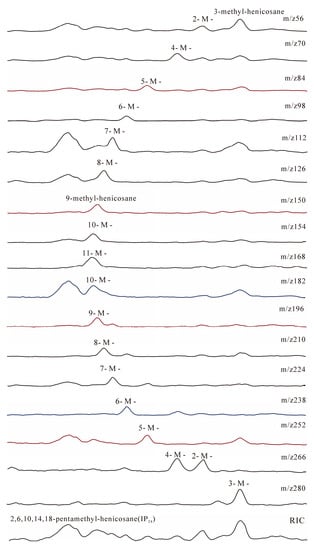
Figure 5.
Mass chromatogram of C22 monomethyl-branched alkanes (from the KP38 coal sample).
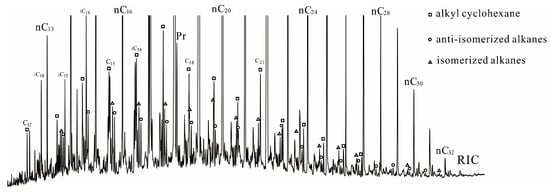
Figure 6.
Distribution of the isomerized alkanes (2-methyl-), anti-isomerized alkanes (3-methyl-), and alkyl cyclohexane series compounds in the coal measures.
In terms of distribution characteristics, these compounds normally do not have a certain carbon dominant distribution or possess a high abundance of 2-methyldocosane. In general, these compounds are distributed in coal, carbonaceous mudstone, and mudstone with relatively low Pr/Ph ratios. The distribution of isomeric (2-methyl-) and anti-isomerized alkanes (3-methyl-) in the literature is mostly associated with terrestrial organic matter in coal or coal-bearing strata [49,50,51]. In fact, a large number of coal-bearing source rocks have also been detected in other coal-bearing basins. It can be seen that the contribution of some bacteria with higher plants as the main carbon source should be an important reason for the relative enrichment of these compounds.
4.2. Distribution Characteristics of Cyclic Terpenoids
4.2.1. Long-Chain Alkyl Cyclohexanes
Under the catalysis of clay minerals, alkyl cyclohexane series compounds can be formed by the thermal evolution and cyclization of algae or bacterial aliphatic acids. This genesis type mostly belongs to short-chain homologs below C21 [52,53]. The C24+ alkyl cyclohexane might be a bacterial metabolite of terrestrial long-chain compounds (such as aliphatic acids and alkanols) that can be used as a marker of bacterial lipid debris. In view of the similarity of the distribution of the alkyl cyclohexane series and n-alkane series, C24+ alkyl cyclohexane homologs may be the bacterial metabolites of aliphatic acid series in higher plants, while C23 alkyl cyclohexane homologs could be mainly formed by the cyclization of microbial aliphatic acids through catalytic thermal evolution. Hence, the alkyl cyclohexane series is also a marker reflecting bacterial activity. Figure 7 illustrates the distribution features of the alkyl cyclohexane series of the coal measure source rocks in the Kuqa Depression.
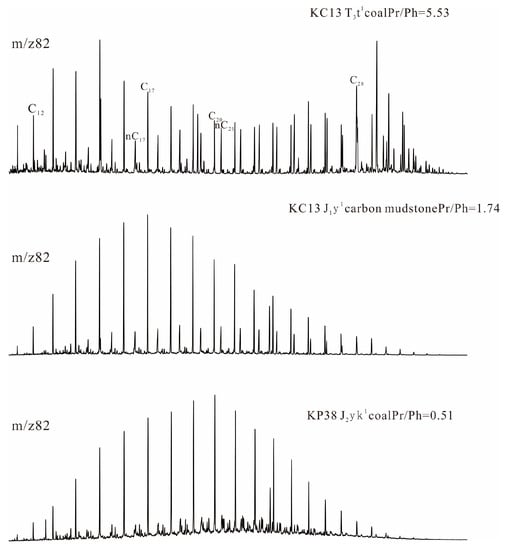
Figure 7.
The distribution characteristics of the alkyl cyclohexane series and relative abundance of n-alkanes in the coal measure source rocks with different Pr/Ph values.
The characteristics of the carbon number of the alkyl cyclohexane series and n-alkanes in the coal measure source rocks of the Kuqa Depression were basically the same. Some samples maintained bimodal distribution characteristics as before (Figure 7) and were generally dominated by low-carbon compounds. The relative abundance of these compounds is obviously related to the sedimentary environment. It can be seen in Figure 7 that with a decrease in the Pr/Ph value, the abundance of the alkyl cyclohexane series compounds increased significantly with the decrease in n-alkanes in the m/z 82 mass chromatogram. The above characteristics may also indicate that the relative abundance of these compounds were mainly associated with the origin of the bacteria and algae.
4.2.2. Tricyclic Terpanes, Tetracyclic Terpanes, and Pentacyclic Triterpenoids
The tricyclic terpane (TT) series compounds were mainly distributed around C19 to C30. The qualitative results of these compounds are shown in Figure 8. In general, the distribution of the tricyclic terpanes can be divided into two basic types. One of them possessed a relatively low abundance of tricyclic terpanes, and the distribution pattern was characterized by C19TT > C20TT > C21TT (Figure 8a). Tricyclic terpanes with a high carbon number (>C25) are extremely undeveloped. The Pr/Ph values of these coal measure source rocks are high (mostly greater than 5), which is completely consistent with the characteristics of the tricyclic terpane distribution pattern of typical coal measure source rocks [53,54]. This was mainly developed in the Kuqa River section. The other one was comparatively rich in tricyclic terpanes, characterized by a high number of high-carbon tricyclic terpanes, and the main peak carbon always belonged to C23TT or C21TT (Figure 8b). The Pr/Ph values of these source rocks were low, generally lower than 1.0, and they were mainly developed in the Kapushaliang River section.
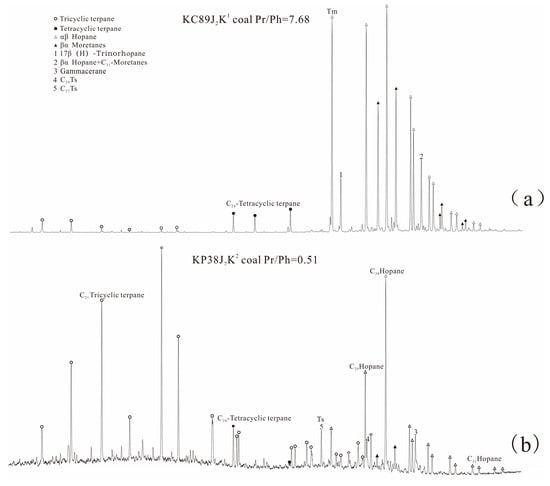
Figure 8.
The distribution characteristics of terpanes in Mesozoic coals with different Pr/Ph ratios in the Kuqa Depression.
There are three common compounds in the tetracyclic terpane series in the coal-bearing strata, with a carbon number range of C24TT-C26TT. The distribution of the tetracyclic terpanes in the Mesozoic source rocks in the Kuqa Depression was the same as that of tricyclic terpanes, and there were also two different patterns (Figure 8). The first was that the tetracyclic terpanes were distributed in a series, the C24~C26 tetracyclic terpane compounds were common, and the abundance of C25 and C26 tetracyclic terpanes was high, corresponding to the first distribution pattern of tricyclic terpanes (Figure 8a), mainly in the Kuqa River section. The second was dominated by C24-tricyclic terpanes; the C25 and C26 tetracyclic terpanes were observed extremely rarely (Figure 8b) and were mainly developed in the Kapushaliang River section.
Triterpenoids primarily include the long-chain αβ hopane series, βα hopane (moretane) series, ββ hopane series, rearranged hopane series, neohopane series, and gammacerane and terrigenous triterpenoids. The ββ hopane series was mainly found in samples with low maturity. All these samples contained 17β(H)-22,29,30-trinorhopane, and the peak elute was after Tm (17α (H)-22,29,30-trinorhopane) (Figure 8a).
The consistent distribution of tricyclic and tetracyclic terpanes and the distribution of the long-chain hopane series with different structures can also be clearly divided into two categories. The first comprises coal-bearing source rocks from the Kuqa River section with a low relative abundance of tricyclic terpanes and developed tetracyclic terpanes. The second comprises βα hopane (moretane) series, which were more developed and possessed a higher content of C31-C33 homomoretane series compounds. The abundance of C29-norhopane and 22,29,30-trinorhopane (Tm) was significantly higher in the αβ hopane series compounds. The Pr/Ph values of the coal measures that were normally higher under this distribution pattern mainly developed in the Kuqa River section. The other distribution characteristics were the opposite of this; the relative abundance of the αβ hopane (moretane) series in the samples from the Kapushaliang River was slightly lower, and the C31-C33 homomoretane series compounds were extremely underdeveloped. In the composition of the αβ-hopane series, the C30-hopane was always dominant, and the abundance of C29-norhopane and 22,29,30-trinorhopane (Tm) was generally lower than that of the C30-hopane. The Pr/Ph values of the coal measures in the distribution pattern were relatively low, and these coal measures were mainly located in the Kapushaliang River section.
4.3. Distribution Characteristics of Sterane Compounds
Sterane compounds are widely used in source rock and crude oil research because of their wide distribution and biological significance. The composition and distribution of steranes in the Mesozoic coal measures in the Kuqa Depression are the same as the composition and distribution of terpenoids. Overall, the composition and distribution of steranes can be divided into two types.
The first type is dominated by humic coal in the Kuqa River section of the Kuqa Depression, in which the regular sterane composition is dominated by C29-; the abundance of C27- and C28- steranes is lower; and the distribution of C27-, C28-, and C29- regular steranes line up to a typical anti-“L” shape. Another significant feature is that the pregnane series is not developed, and the content is extremely low (Figure 9a).
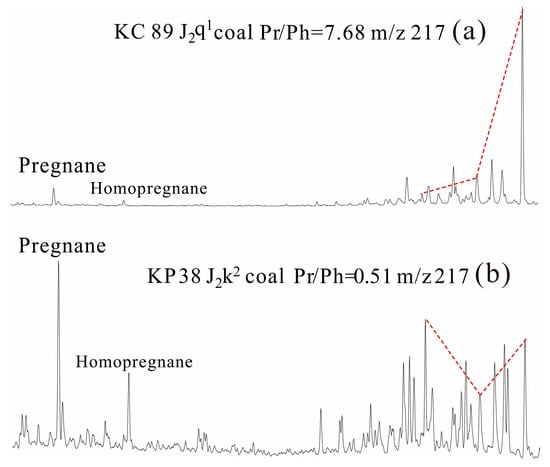
Figure 9.
The distribution characteristics of steranes in the Mesozoic coals with different Pr/Ph ratios in the Kuqa Depression.
On the contrary, the second type is a typical representative of the coal rock in the Kapushaliang River section, and its manifestation is that the regular C27-, C28-, and C29- steranes are distributed in a “V” shape, reflecting a significant increase in the contribution of lower biogenic organic matter. It is particularly significant that the pregnane series is well-developed in this distribution type, in sharp contrast to the first type (Figure 9b). In summary, although the coal rocks of the Kuqa River section and the Kapushaliang section are all humic coals, the parent material of the steranes in the two sections is obviously different.
4.4. Biomarker Compound combination and Its Significance
The combination of the characteristics of the biomarkers comprehensively reflects the reproduction of living organisms under different environmental conditions, the preservation conditions of the organic matter, and the evolution of hydrocarbon generation. Combined with the distribution characteristics of the alkanes, cyclic terpenoids, and steranes, in addition to the conventional biomarkers, more developed high-carbon regular isoprenoid alkanes were detected in this study area, as well as some biomarkers related to bacterial or algal biogenesis, such as isomerism (2-methyl-) and anti-isomerism (3-methyl-) alkanes in monomethyl branched alkanes, alkyl cyclohexane series, and some methyl compounds with specific carbon numbers (2-methyldocosane). Although the coal and rock samples from the Kuqa River section and the Kapushaliang section in the Kuqa Depression are both humic coals; the combination and distribution of biomarker compounds have obvious particularity, and the mechanism of their formation and the major controlling factors are still to be explored.
4.4.1. Thermal Evolution Degree of Organic Matter
Because the measured vitrinite reflectance Ro data in the coal measure source rock samples in this paper were limited and Ro is positively correlated with the maturity index Tmax. Tmax were used instead of Ro to characterize the maturity of the samples. The Ro values of the Kuqa River section samples were relatively low, ranging from 0.511% to 0.696%, and the corresponding Tmax distribution ranged from 430 °C to 454 °C. The Ro values of the samples from the Kapushaliang River section were higher, between 0.984% and 1.485%, and the corresponding Tmax distribution range was 466~529 °C (Table 1).
Figure 10a reveals the relationship between the Pr/Ph ratio and the maturity in the samples from the Kuqa River section and the Kapushaliang River section. The Tmax of the coal-bearing source rock samples from the Kuqa River section varied within a small range, from 430 °C to 454 °C, but the Pr/Ph ratio varied greatly. On the contrary, the maturity span of the coal measure source rock samples from the Kapushaliang River section was large, and the Tmax was between 466 °C and 529 °C, but the Pr/Ph ratio did not increase significantly with the increase in maturity; that is to say, there was no significant influence on the maturity or the Pr/Ph ratio of the source rock (Table 1).
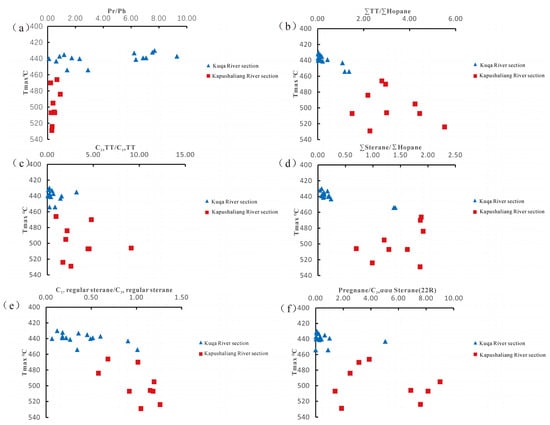
Figure 10.
Biomarker ratio cross-plots: (a) Pr/Ph vs. Tmax; (b) ∑TTs/∑HOPs vs. Tmax; (c) C23TT/C19TT vs. Tmax; (d) ∑sterane/∑hopane vs. Tmax; (e) C27 regular sterane/C29 regular sterane vs. Tmax; (f) pregnane/C29αααsterane (20R) vs. Tmax. Note: ∑TTs/∑HOPs:C19 to C31 (excluding C22 and C27) tricyclic terpanes/C29-C35 hopanes; ∑sterane/∑hopane:C27-C29 steranes/C29-C35 hopanes.
With the increase in maturity, tricyclic terpanes are preferentially released from kerogen or asphaltene, and their thermal stability is stronger than that of hopanes, resulting in a higher relative abundance of tricyclic terpanes than hopanes [55,56]. To investigate the relationship between the tricyclic terpane parameters and maturity in the Kuqa Depression, the parameters of the ∑tricyclic terpane/total ∑hopane and the tricyclic terpane monomer compound (C23TT/C19TT) were selected, and the two parameters showed that the Tmax of the samples from the Kuqa River section changed slightly; as for the ∑tricyclic terpane/∑hopane ratio, there was no significant change in the C23TT/C19TT ratio. Similarly, with the increase in the maturity of the coal measure source rocks in the Kapushaliang River section, there was no direct correlation between the ∑tricyclic terpane/∑hopane ratio and the C23TT/C19TT ratio and Tmax. It can be seen that maturity had a very limited effect on the ratio of the tricyclic terpane compounds in the samples from the study area (Figure 10b,c).
In addition to the parameters of the tricyclic terpane compounds, the ratio of ∑sterane/∑hopane and the ratios of the single sterane compounds, C27 regular sterane/C29 regular sterane and pregnane/C29αααsterane (20R), also showed similar regularity to the parameters of the tricyclic terpane compounds in the source rock samples from two different sections in the study area. The Tmax of the coal measure source rocks in the Kuqa River section varied slightly from 430 °C to 454 °C, and the ratios of ∑sterane/∑hopane and pregnane/C29αααsterane (20R) did not change significantly, but the ratio of C27 regular sterane/C29 regular sterane varied greatly, indicating that maturity was not the main factor influencing these parameters. The Tmax of the coal measure source rocks in the Kapushaliang River section varied greatly from 466 °C to 529 °C. The ∑sterane/∑hopane ratio, C27 regular sterane/C29 regular sterane ratio, and pregnane/C29αααsterane (20R) ratio had no obvious linear correlation with Tmax, and the results indicated that the variation in the sterane compounds in the coal measure source rocks in the research area was not controlled by the degree of the thermal evolution of the organic matter (Figure 10d–f).
In summary, the correlation between the maturity parameters (Tmax) of the source rocks in the study area, the sedimentary environment, and the parameters of the parent material revealed that maturity is not a critical factor in the difference in the biomarker composition of the coal measure rocks in the Kuqa River section and the Kapushaliang River section of the Kuqa Depression in the Tarim Basin. The cause of these differences was mainly due to the reduction of the source rock deposit and the difference in the hydrocarbon-generating parent material.
4.4.2. Oxidative Reducibility of Sedimentary Environment
From the perspective of sedimentology, the Kuqa Depression mainly develops lake-shore-shallow lake-swamp facies sedimentary environments [57]. However, from the perspective of molecular geochemistry, the environmental parameters, such as gammacerane ratio (Ga/C31H) and pristine ratio (Pr/Ph), of the coal-bearing source rocks in the Kuqa River section and the Kapushaliang River section are obviously different. In addition, a series of parameters related to the sedimentary environment and biogenic parent materials were selected for comparative study, such as the ∑tricyclic terpane (TT)/∑hopane ratio, C23TT/C19TT ratio, C23TT/C30H ratio, ∑hopane/∑tricyclic terpane ratio, and pregnane/C29αααsterane (20R) ratio (Table 2).
Gammacerane (Ga) can better reflect the salinity and stratification of the sedimentary environment [58]. Mann [59] reported a negative correlation between the Pr/Ph ratio and the gammacerane content and proposed that abundant gammacerane suggests a highly reducing hypersaline environment in the deposition of organic matter. The Pr/Ph ratio and gammacerane content of the coal measure source rocks in the different sections of the study area were quite different. The Pr/Ph ratio of coal measure source rocks in the Kuqa River section was relatively high; the subject was greater than 2.0, and the average value was 5.82. On the contrary, the content of gammacerane in the coal measure source rocks was extremely low, and the Ga/C31H ratio was mostly distributed between 0.03 and 0.26, with an average of 0.1 (Table 2), revealing that these samples mainly developed in a freshwater partial oxidation environment. The Pr/Ph ratios of the coal measure source rock samples from the Kapushaliang River section were significantly lower; the subject was less than 1.0, and the average value was 0.46. However, the content of gammacerane in the coal measure source rock samples from the Kapushaliang River section was abnormally high, and the Ga/C31H ratio was between 0.57 and 1.33, with an average value of 0.74 (Table 2), suggesting that these samples mainly developed in a saline water partial reduction environment. In Figure 11a, it is further revealed that the sedimentary environment and water salinity of the samples from the Kuqa River section and the Kapushaliang River section were quite different. In general, the Pr/Ph ratio of lacustrine humic coal was high, and the gammacerane was not developed; however, the Pr/Ph ratio of the humic coal in the Kapushaliang River section was low, and the gammacerane was developed, indicating that the hydrocarbon-forming environment of the humic coal in the Kapushaliang River section is special.
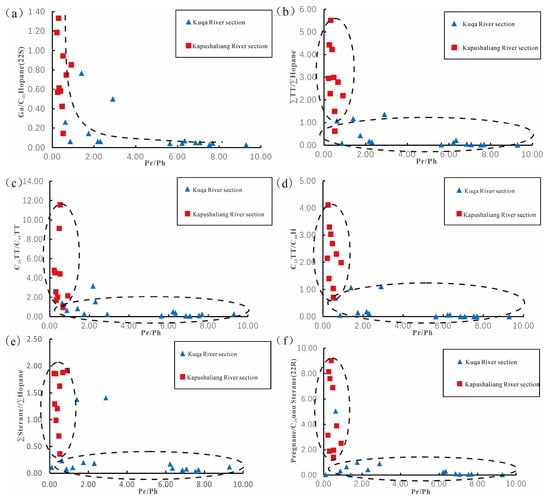
Figure 11.
Biomarker ratio cross-plots: (a) Ga/C31H vs. Pr/Ph; (b) ∑TTs/∑HOPs vs. Pr/Ph; (c) C23TT/C19TT vs. Pr/Ph; (d) C23TT/C30H vs. Pr/Ph; (e) ∑sterane/∑hopane vs. Pr/Ph; (f) pregnane/C29αααsterane (20R) vs. Pr/Ph. Note: ∑TTs/∑HOPs:C19 to C31 (excluding C22 and C27) tricyclic terpanes/C29-C35 hopanes; ∑sterane/∑hopane:C27-C29 steranes/C29-C35 hopanes.
The difference in the hydrocarbon-generating environment between the two profile samples from the study area may have been caused by the difference in the hydrocarbon-generating parent materials. Previous studies have shown that the ratio of tricyclic terpane/hopane can be used to compare the lipid bodies (tricyclic terpanes) of bacteria or algae with the markers (hopanes) generated by different prokaryotes. For comparison, the ∑tricyclic terpane/∑hopane ratio, C23TT/C19TT ratio, and C23TT/C30H ratio were selected to study the variation of tricyclic terpanes in the coal measure source rock samples from the two profiles. The ∑tricyclic terpane/∑hopane ratio (distribution subject between 0.02 and 1.08), C23TT/C19TT ratio (distribution subject between 0.08 and 0.66), and C23TT/C30H ratio (distribution subject between 0.004 and 0.068) of the coal-bearing source rocks in the Kuqa River section were all smaller than the ∑tricyclic terpane/∑hopane ratio (distribution subject between 1.50 and 5.52), C23TT/C19TT ratio (distribution subject between 1.70 and 11.57), and the C23TT/C30H ratio (distribution subject between 0.707 and 4.115) of the coal-bearing source rocks in the Kapushaliang River section (Table 2). The sample points in the Kuqa River section and the Kapushaliang River section were distributed in two different regions, as shown in Figure 11 (Figure 11b–d), indicating that the differences in these three parameters were very obvious and reflecting that there were also obvious differences in the hydrocarbon-generating parent materials of the coal measure source rocks in the two sections.
For comparison, in addition to the tricyclic terpane parameters, the sterane compound parameters were also selected, namely, the total ∑sterane/∑hopane ratio and the ratio of the individual sterane compounds (pregnane/C29αααsterane (20R)). These two parameters could also effectively distinguish the Kuqa River section and the Kapushaliang River section (Figure 11e,f). The specific results were that the ∑sterane/∑hopane ratio (distribution range from 0.04 to 0.2) and the pregnane/C29αααsterane (20R) ratio (distribution range from 0.023 to 0.659) of the coal measure source rocks in the Kuqa River section were smaller than the ∑sterane/∑hopane ratio (distribution range from 0.99 to 1.91) and the pregnane/C29αααsterane (20R) ratio (distribution range from 1.408 to 9.014) of the coal measure source rocks in the Kapushaliang River section (Table 2). This phenomenon may be due to changes in the sedimentary environment, which lead to obvious differences in the hydrocarbon-generating parent material.
In summary, the correlation between the Pr/Ph ratio and the gammacerane ratio (Ga/C31H), total tricyclic terpane to total hopane ratio (∑tricyclic terpane/∑hopane), tricyclic terpane monomer compound ratio (C23TT/C19TT, C23TT/C30H), and total sterane to total hopane ratio (∑sterane/∑hopane, pregnane/C29αααsterane (20R)) effectively distinguished the coal measure source rocks in the Kuqa River section from the coal measure source rocks in the Kapushaliang River section (Figure 11). The humic coal in the Kuqa River section showed a higher Pr/Ph ratio and a lower gammacerane ratio, and its sedimentary environment is a slightly oxidized freshwater lake–swamp facies coal-forming environment [60]. On the contrary, the Pr/Ph ratios in the coal measure source rock samples from the Kapushaliang River section were low—less than 1.0. However, the Ga/C31H (22S) ratio, ∑tricyclic terpane/∑hopane ratio, C23TT/C19TT ratio, C23TT/C30H ratio, ∑sterane/∑hopane ratio, and pregnane/C29αααsterane (20R) ratio were all larger than those of the Kuqa River section, indicating that the hydrocarbon-forming environment of the samples from the Kapushaliang River section is a partially reduced saline water environment. It has been reported in the literature that the coal-bearing source rocks of the Kapushaliang River section were subjected to transgression during the coal-forming process, resulting in a completely different hydrocarbon-generating parent material from that in the Kuqa River section [60,61,62].
4.4.3. Hydrocarbon-Generating Parent Material of the Source Rock
The difference in the sedimentary environmental parameters in the coal measure source rocks of the Kuqa River section and the Kapushaliang River section is mainly caused by transgression. This phenomenon caused the hydrocarbon-generating parent materials in the Kuqa River section and the Kapushaliang River section to be significantly different. Therefore, the ∑tricyclic terpane/∑hopane ratio, pregnane/C29αααsterane (20R) ratio, and C27 sterane/C29 sterane ratio were selected to be studied for their correlation. It has been reported that tricyclic terpanes are mainly derived from aquatic algae and microorganisms, and hopanes are derived from bacteria and some fern precursors [54]. From Figure 12a, it can be seen that there was a significant positive correlation between pregnane/C29αααsterane (20R) and ∑tricyclic terpane/∑hopane. This shows that the characteristics of the increasing relative abundance of the pregnane series were similar to those of the tricyclic terpanes and that the biogenic characteristics of the pregnane series in the Mesozoic coal measures in the Kuqa Depression should be approximately the same as those of the tricyclic terpanes.

Figure 12.
Biomarker ratio cross-plots: (a) pregnane/C29αααsterane (20R) vs. TTs/∑HOPs; (b) C27 sterane/C29 sterane vs. TTs/∑HOPs. Note: ∑TTs/∑HOPs:C19 to C31 (excluding C22 and C27) tricyclic terpanes/C29-C35 hopanes.
Sterane compounds are almost all derived from eukaryotes. It is commonly believed that C27 sterols and C27 steranes are abundant in aquatic organisms, whereas higher plants contain C29 steranes [63]. From Figure 12b it can also be seen that the total C27 sterane/total C29 sterane ratio was positively correlated with the ∑tricyclic terpane/∑hopane ratio. The total C27 sterane/total C29 sterane ratios of coal measure source rock samples from the Kuqa River section were less than 1.0, ranging from 0.08 to 0.96. The ratio of total C27 sterane/total C29 sterane in the coal measure source rocks from the Kapushaliang River section was greater than 1.0, which is between 1.06 and 1.54 (Table 2). Moreover, the C27 sterane/C29 sterane ratios of the coal measure source rock samples from the Kapushaliang River section were significantly higher than that in the Kuqa River section, indicating that the input of terrestrial organic matter from source rock in the Kuqa River section is much higher than that in the Kapushaliang River section, while the samples from the Kapushaliang River section are mainly bacteria or algae formed by the transformation of higher plants by microorganisms.
In the coal-forming environment dominated by higher plant input, the secondary yield of the organic matter may be of great significance. This significance can be reflected in the following aspects. First, the input of a large amount of higher plant organic matter in a coal-forming environment provides a sufficient carbon source for chemoheterotrophic microorganisms, with higher plants as the carbon source providing sufficient material conditions for the flourishing of microorganisms. This is an inherent condition that marine sedimentary basins do not have. Second, unlike lacustrine and marine environments, the organic matter provided by the original yield in the coal-forming environment was characterized by poor hydrogen, whereas heterotrophic microorganisms provided microbial lipids with a significantly higher degree of hydrogen enrichment while degrading and consuming higher plants. That is to say, the secondary yield of organic matter produced by the metabolic process of heterotrophic microorganisms greatly improves the organic matter of higher plants. Third, heterotrophic microorganisms greatly consume the free oxygen of sedimentary water columns or sediments while improving high plant organic matter so that the water conditions appear to be a reducing environment, which is conducive to the preservation of organic matter.
5. Conclusions
(1) According to the diverse geochemical properties of the saturated hydrocarbon biomarker compounds in the coal measure source rocks in the study area, it was found that the biomarker combinations of the coal measure source rocks in the Jurassic–Triassic Kuqa River section and Kapushaliang River section in the Kuqa Depression were very different, suggesting that their coal-forming environment and main controlling factors were different.
(2) A correlation study on the parameters of the organic matter maturity of the source rocks in the two sections of the study area showed that the degree of evolution of the organic matter in the coal measure source rocks was not the key factor affecting the difference in the biomarker combination of the coal measure source rocks in the Kuqa River section and Kapushaliang River section in the Kuqa Depression, Tarim Basin.
(3) A study on the correlation between the sedimentary environment of the source rocks and the parameters of the biomarker compounds in the two sections of the study area revealed that the samples from the Kuqa River section were deposited in the oxidized freshwater lake facies; the samples from the Kapushaliang River section were deposited in a strongly reducing saline water environment. The main reason for this phenomenon is that the source rocks of the Kapushaliang River section were subjected to transgression during the coal-forming process. In other words, the difference between the two profiles of the coal source rocks was mainly caused by the change in the sedimentary environment in the later period, which led to different hydrocarbon-forming parent materials.
Author Contributions
W.Z. (Wenjun Zhang)—conceptualization, methodology, writing, and editing; W.Z. (Wenyu Zhang)—data processing and article modification, elaboration, and review; S.L.—review, experimental analysis, and data processing; X.K.—data processing; W.X.—data processing; T.H.—data processing; M.Z.—conceptualization, review, and funding acquisition. All authors have read and agreed to the published version of the manuscript.
Funding
The financial support was provided by the National Natural Science Foundation of China (No. 42072165).
Data Availability Statement
The data used to support the findings of this study are included within the article.
Acknowledgments
We would like to thank the Key Laboratory of Exploration Technology for Oil and Gas Research for allowing us to conduct the GC/MS analyses on the saturated and hydrocarbons of the coal measure source rock. We are grateful to CuiShan Zhu for his valuable assistance during the GC/MS analyses. Furthermore, the authors would like to thank the three anonymous reviewers for their valuable discussion and review of this manuscript.
Conflicts of Interest
The authors declare no conflict of interest.
References
- Li, Z.X.; Zhang, G.C.; Li, Y.; Liu, H.Y.; Lv, D.W.; Shen, H.L. The Paleogene coal-bearing basin and coal measures distribution of China sea area. Front. Earth Sci. 2012, 19, 314–326. [Google Scholar]
- Li, Z.X.; Song, G.Z.; Wang, D.D.; Zhang, G.C.; Chen, Y.; Lu, D.W. Characteristics of (fan) braided river delta in coal measures of Oligocene Yacheng Formation in Qiongdongnan basin. Geoscience 2018, 43, 3471–3484. [Google Scholar]
- Wang, D.D.; Shao, L.Y.; Li, Z.X.; Lv, D.; Liu, H.Y. Hydrocarbon generation characteristics, reserving performance and preservation conditions of continental coal measure shale gas: A case study of MidJurassic shale gas in the Yanan Formation, Ordos Basin. J. Pet. Sci. Eng. 2016, 145, 609–628. [Google Scholar] [CrossRef]
- Wang, D.D.; Li, Z.X.; Liu, H.Y.; Lu, D.W.; Dong, G.Q. The genetic environmental transformation mechanism of coal and oil shale deposits in Eastern China’s continental fault basins and the developmental characteristics of the area’s symbiotic assemblages—Take Huangxian basin as an example. Pet. Sci. 2019, 16, 469–491. [Google Scholar] [CrossRef]
- Yan, L.I. Characteristics and mechanism of source rock development controlled by sedimentary microfacies in river-delta system: Case study of coal-measure source rock in Enping Formation in Pearl River Estuary Basin. Geoscience 2021, 35, 1065. [Google Scholar]
- Levine, J.R. Coalification: The evolution of coal as source rock and reservoir rock for oil and gas: Chapter 3. In SG 38: Hydrocarbons from Coal; AAPG: Tulsa, OK, USA, 1993. [Google Scholar]
- Zhang, G.; Wang, D.; Zeng, Q.; Yang, H.; Li, Z.; Zhao, Z.; Guo, S. Characteristics of coal-measure source rock and gas accumulation belts in marine-continental transitional facies fault basins: A case study of the Oligocene deposits in the Qiongdongnan Basin located in the northern region of the South China Sea. Energy Explor. Exploit. 2019, 37, 1752–1778. [Google Scholar]
- Boreham, C.J.; Powell, T.G. Petroleum Source Rock Potential of Coal and Associated Sediments: Qualitative and Quantitative Aspects: Chapter 6. In SG 38: Hydrocarbons from Coal; AAPG: Tulsa, OK, USA, 1993. [Google Scholar]
- Lutz, M.; Kaasschieter, P.H.; Van Wijhe, H. Geological factors controlling Rotliegend gas accumulations in the Mid-European Basin. In Proceedings of the World Petroleum Congress, WPC, Tokyo, Japan, 11–16 May 1975. WPC-16109. [Google Scholar]
- Glennie, K.W. Development of NW Europe’s Southern Permian gas basin. Geol. Soc. Lond. Spec. Publ. 1986, 23, 3–22. [Google Scholar] [CrossRef]
- Macgregor, D.S. Coal-bearing strata as source rocks a global overview. Geol. Soc. Lond. Spec. Publ. 1994, 77, 107–116. [Google Scholar] [CrossRef]
- Li, J.; Hao, A.; Qi, X.; Chen, X.; Guo, J.; Ran, Q.; Li, Z. Geochemical characteristics and exploration potential of Jurassic coal-formed gas in northwest China. J. Nat. Gas Geosci. 2019, 4, 321–335. [Google Scholar] [CrossRef]
- Su, S.; Zhao, Y.; Pu, R.; Chen, S.; Ji, T.; Yao, W. Growth and Distribution of Coal-Measure Source Rocks in Mixed Platform: A Case Study of Carboniferous in Bamai Area, Southwest Tarim Basin, China. Energies 2022, 15, 5712. [Google Scholar] [CrossRef]
- Pashin, J.C. Coal as a petroleum source rock and reservoir rock. In Applied Coal Petrology; Elsevier: Amsterdam, The Netherlands, 2008; pp. 227–262. [Google Scholar]
- Mi, J.; Zhang, S.; Hu, G.; He, K. Geochemistry of coal measure source rocks and natural gases in deep formations in Songliao Basin, NE China. Int. J. Coal Geol. 2010, 84, 276–285. [Google Scholar] [CrossRef]
- Chang, J.; Chen, S.Y.; Liu, K.Y.; Wang, Q.; Pu, X.G.; Yang, H.Y. Distribution characteristics and depositional environment of the Late Paleozoic coal-measure source rocks in the Bohai Bay Basin region. Arab. J. Geosci. 2021, 14, 6271-13. [Google Scholar] [CrossRef]
- Khorasani, G.K. Factors controlling source rock potential of the Mesozoic coal-bearing strata from offshore central Norway: Application to petroleum exploration. Bull. Can. Pet. Geol. 1989, 37, 417–427. [Google Scholar]
- Sykes, R.; Snowdon, L.R. Guidelines for assessing the petroleum potential of coaly source rocks using Rock-Eval pyrolysis. Org. Geochem. 2002, 33, 1441–1455. [Google Scholar] [CrossRef]
- Ren, J.; Wang, H.; Sun, M.; Gan, H.; Song, G.; Sun, Z. Sequence stratigraphy and sedimentary facies of Lower Oligocene Yacheng Formation in deepwater area of Qiongdongnan Basin, Northern South China Sea: Implications for coal-bearing source rocks. J. Earth Sci. 2014, 25, 871–883. [Google Scholar] [CrossRef]
- Ouyang, Y.L.; Tian, W.G.; Sun, B.; Wang, B.; Ling, Q.; Dong, H. Characteristics of coal measure gas accumulation and such gas exploration strategies in China. Nat. Gas Ind. 2018, 38, 15–23. [Google Scholar] [CrossRef]
- Thomas, B.M. Landplant source rocks for oil and their significance in Australian basins. APPEA J. 1982, 22, 164–178. [Google Scholar] [CrossRef]
- Durand, B.; Parratte, M.; Bertrand, P. The Oil Potential of Coals: A Geochemical Approach. Oil Gas Sci. Technol. Rev. D’ifpen 1983, 38, 709–721. [Google Scholar] [CrossRef]
- Wilkins, R.; George, S.C. Coal as a source rock for oil: A review. Int. J. Coal Geol. 2002, 50, 317–361. [Google Scholar] [CrossRef]
- Meng, J.H.; Zhang, M.; Zhao, H.J.; Liu, L.F.; Wang, Z.Y.; Zhou, J.L.; Wang, Y. Geochemical Evidence for Coal and Carbonaceous Mudstone as the Possible Major Oil Source Rock in the Jurassic Turpan Basin, Northwest China. Acta Geol. Sin. 2012, 86, 11. [Google Scholar]
- Chen, J.P.; Deng, C.P.; Wang, H.T. Biomarker characteristics of extracts from source rocks in coal measures with different polarity solvents. Acta Geol. Sin. 2006, 80, 916–922. [Google Scholar]
- Fang, C.; Wu, W.; Liu, D. Evolution characteristics and application of diamondoids in coal measures. J. Nat. Gas Geosci. 2016, 1, 93–99. [Google Scholar] [CrossRef]
- Smith, J.W.; Gould, K.W.; Hart, G.H.; Rigby, D. Isotopic studies of Australian natural and coal seam gases. AIMM Bull. Proc. 1985, 290, 43–51. [Google Scholar]
- Kong, T.; Zhang, M. Effects of depositional environment on rearranged hopanes in lacustrine and coal measure rocks. J. Pet. Sci. Eng. 2018, 169, 785–795. [Google Scholar] [CrossRef]
- Zhao, H.J.; Zhang, M.; Wang, Z.Y. Oil and gas potential assessment for coal measure source rocks on absolute concentration of n-alkanes and aromatic hydrocarbons. Sci. China Ser. D Earth Sci. 2009, 52 (Suppl. S1), 51–58. [Google Scholar] [CrossRef]
- Wang, X.C.; Li, J.Q.; Huang, Y.H.; Lu, S.F.; Chen, K.T.; Wei, Y.B.; Song, Z.J.; Zhao, R.X.; He, T.H. Influence of Paleosedimentary Environment on Shale Oil Enrichment in the Raoyang Sag, Bohai Bay Basin. Energy Fuels 2022, 36, 13597–13616. [Google Scholar] [CrossRef]
- Li, Y.; Deng, Y.H.; Li, Y.C. Study on Organic Facies of Jurassic Coal Measure Source Rocks in Yanqi Basin. Xinjiang Pet. Geol. 2021, 25, 41. [Google Scholar]
- Teichert, Z.; Bose, M.; Williams, L.B. Lithium isotope compositions of US coals and source rocks: Potential tracer of hydrocarbons. Chem. Geol. 2020, 549, 119694. [Google Scholar] [CrossRef]
- He, T.H.; Li, W.H.; Lu, S.F.; Yang, E.Q.; Jing, T.T.; Ying, J.F.; Zhu, P.F.; Wang, X.Z.; Pan, W.Q.; Chen, Z.H. Distribution and isotopic signature of 2-alkyl-1,3,4-trimethylbenzenes in the Lower Paleozoic source rocks and oils of Tarim Basin: Implications for the oil-source correlation. Pet. Sci. 2022, 19, 2572–2582. [Google Scholar] [CrossRef]
- He, T.H.; Zeng, Q.H.; Lu, S.F.; Li, W.H.; Li, M.Q.; Wen, Z.G.; Yang, E.Q.; Jing, T.T.; Ying, J.F.; Zhu, P.F.; et al. Aryl isoprenoids from the Lower Paleozoic in the Tarim Basin, NW China: Insight into deep ancient hydrocarbon exploration. Geoenergy Sci. Eng. 2023, 225, 211666. [Google Scholar] [CrossRef]
- He, T.H.; Li, W.H.; Lu, S.F.; Yang, E.Q.; Jing, T.T.; Ying, J.F.; Zhu, P.F.; Wang, X.Z.; Pan, W.Q.; Zhang, B.S.; et al. Quantitatively unmixing method for complex mixed oil based on its fractions carbon isotopes: A case from the Tarim Basin, NW China. Pet. Sci. 2023, 20, 102–113. [Google Scholar] [CrossRef]
- Cheng, Q.S.; Huang, G.H.; Zhang, M. Distribution and source significance of 2-methylalkanes in coal-measure source rocks, northwest China. J. Pet. Sci. Eng. 2019, 174, 257–267. [Google Scholar] [CrossRef]
- Liu, R.; Li, J.; Xiao, Z.; Li, J.; Liu, M. Geochemical characteristics and their gas and oil prone correlation implication in the Tugeerming area of the Kuqa Depression, Tarim Basin, China. J. Nat. Gas Geosci. 2019, 4, 161–168. [Google Scholar] [CrossRef]
- Gao, T.; Ding, X.; Yang, X.; Chen, C.; Xu, K.; Zhang, X. Geochemical Characteristics and Depositional Environment of Coal-Measure Hydrocarbon Source Rocks in the Northerm Tectonic Belt, Kuqa Depression. Appl. Sci. 2022, 12, 9464. [Google Scholar] [CrossRef]
- Fan, S.; Lu, Y.H.; Li, L.; Wei, H.; Zhang, H.F.; Shen, L. Geochemical characteristics, distribution and petroleum geological significance of TriassicJurassic source rocks in the Tugeerming and surrounding areas of Kuqa Depression, Tarim Basin. Nat. Gas Geosci. 2022, 33, 2074–2086. [Google Scholar]
- Wan, J.; Gong, Y.; Zhuo, Q.; Lu, X.; Huang, W. Fluid inclusion characteristics of the Jurassic reservoir and hydrocarbon accumulation process in the eastern Kuqa Depression, Tarim Basin. J. Pet. Explor. Prod. Technol. 2023, 13, 523–541. [Google Scholar] [CrossRef]
- Li, X.Q.; Xiao, X.M. The kinetics of hydrocarbon generation in Jurassic coal-measure source rocks, Kuqa Depression, Tarim Basin. Xinjiang Pet. Geol. 2003, 24, 487. [Google Scholar]
- Zhang, J.; Chen, J.P.; Zhang, C.M.; Wang, P.R. Variation characteristics of coal biomarker composition with maturity in Kuqa Depression. J. Pet. Nat. Gas 2002, 24, 27–29. [Google Scholar]
- Wang, T.G.; Simoneit, B.R.T.; Philp, R.P.; Yu, C.P. Extended 8. Beta(H)-drimane and 8, 14-secohopane series in a Chinese boghead coal. Energy Fuels 1990, 4, 177–183. [Google Scholar] [CrossRef]
- Wang, T.G.; Simoneit, B.R.T. Tricyclic terpanes in Precambrian bituminous sandstone from the eastern Yanshan region, North China. Chem. Geol. 1995, 120, 155–170. [Google Scholar] [CrossRef]
- Connan, J.; Bouroullec, J.; Dessort, D.; Albrecht, P. The microbial input in carbonateanhydrite facies of a sabkha palaeoenvironment from Guatemala: A molecular approach. Org. Geochem. 1986, 10, 29–50. [Google Scholar] [CrossRef]
- Peters, K.E.; Walters, C.C.; Moldowan, J.M. The Biomarker Guide; Cambridge University Press: Cambridge, UK, 2005. [Google Scholar]
- Teng, L.; Zhang, M. Origin and significance of 2-and 3-methylalkanes in coal and carbonaceous mudstone from the Kuqa Depression, Tarim Basin. Arab. J. Geosci. 2021, 14, 1823. [Google Scholar] [CrossRef]
- Shiea, J.; Brassell, S.C.; Ward, D.M. Mid-chain branched mono-and dimethyl alkanes in hot spring cyanobacterial mats: A direct biogenic source for branched alkanes in ancient sediments. Org. Geochem. 1990, 15, 223–231. [Google Scholar] [CrossRef]
- Chaffee, A.L.; Hoover, D.S.; Johns, R.B. Biological markers extractable from coal. In Biological Markers in the Sedimentary Record; Elsevier: Amsterdam, The Netherlands, 1986; pp. 311–345. [Google Scholar]
- Philp, R.P.; Lewis, C.A. Organic Geochemistry of Biomarkers. Annu. Rev. Earth Planet. Sci. 1987, 15, 363–395. [Google Scholar] [CrossRef]
- Huang, G.H.; Wang, T.G.; Zhong, N.N.; Xiong, B. Compositional characteristics of the Jurassic crude oil and oil-source correlation in Beipiao basin. J. Jianghan Pet. Inst. 1993, 15, 21–27. [Google Scholar]
- Fowler, M.G.; Abolins, P.; Douglas, A.G. Monocyclic alkanes in Ordovician organic matter. Org. Geochem. 1986, 10, 815–823. [Google Scholar] [CrossRef]
- Zhu, Y.M.; Mei, B.W. Geochemical characteristics of Mesozoic coal seams in Tarim Basin. Xinjiang Pet. Geol. 1998, 19, 5. [Google Scholar]
- Zhu, Y.M. Geochemical Characteristics of Terrestrial Oils of the Tarim Basin. J. Sedimentol. 1997, 15, 26–30. [Google Scholar]
- Tuo, J.C.; Wang, X.B.; Chen, J.F. Distribution and evolution of tricyclic terpanes in lacustrine carbonates. Org. Geochem. 1999, 30, 1429–1435. [Google Scholar]
- Aquino Neto, F.R.; Trendel, J.M.; Restle. Occurrence and formation of tricyclic and tetracyclic terpanes in sediments and petroleum. Adv. Org. Geochem. 1981, 1983, 659–667. [Google Scholar]
- Zhang, B.M.; Chen, J.P.; Bian, L.Z.; Zhang, S.C. Rediscussion on Triassic-Jurassic Ocean Flooding Events in Kuqa Depression, Tarim Basin. Acta Geol. 2006, 80, 236–244. [Google Scholar]
- Moldowan, J.M.; Albrecht, P.; Philp, R.P. Biological Markers in Sediments and Petroleum; 1992. Available online: https://www.osti.gov/biblio/5867806 (accessed on 5 September 2023).
- Mann, A.L.; Goodwin, N.S.; Lowe, S. Geochemical Characteristics of Lacustrine Source Rocks: A Combined Palynological/Molecular Study of a Tertiary Sequence from Offshore China; AAPG: Tulsa, OK, USA, 1987; Volume 1, pp. 241–258. [Google Scholar]
- Zhang, M.; Xiang, W.; Zhang, W.J.; Li, H.B. Study on the reasons for abnormal distribution of Jurassic humic coal tricyclic terpanes in Kuqa Depression. J. Yangtze Univ. Nat. Sci. Ed. 2023, 1–15. [Google Scholar]
- Zhou, S.X.; Li, Y.; Zhang, Z.N.; Luo, B.J.; Yuan, J.Y.; Duan, Y. Influence on organic matter caused by Mesozoic Transgressive events in the Kuqa Depression, Tarim Basin. Sediment. J. 1999, 106–111. [Google Scholar]
- Chen, R.L. Rediscussion on the Middle Jurassic Flooding Event Deposits in the Tarim Basin. Pet. Geol. Exp. 1995, 17, 311–315. [Google Scholar]
- Huang, W.Y.; Meinschein, W.G. Sterols as Ecological Indicators. Geochim. Cosmochim. Acta 1979, 43, 739–745. [Google Scholar] [CrossRef]
Disclaimer/Publisher’s Note: The statements, opinions and data contained in all publications are solely those of the individual author(s) and contributor(s) and not of MDPI and/or the editor(s). MDPI and/or the editor(s) disclaim responsibility for any injury to people or property resulting from any ideas, methods, instructions or products referred to in the content. |
© 2023 by the authors. Licensee MDPI, Basel, Switzerland. This article is an open access article distributed under the terms and conditions of the Creative Commons Attribution (CC BY) license (https://creativecommons.org/licenses/by/4.0/).